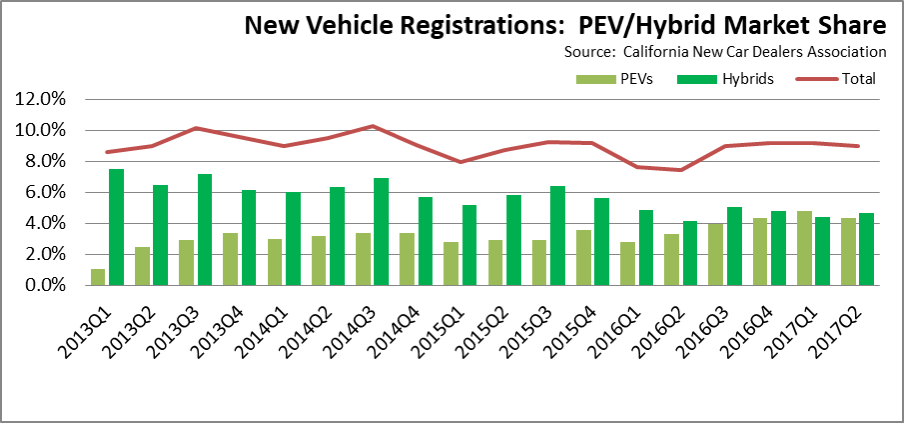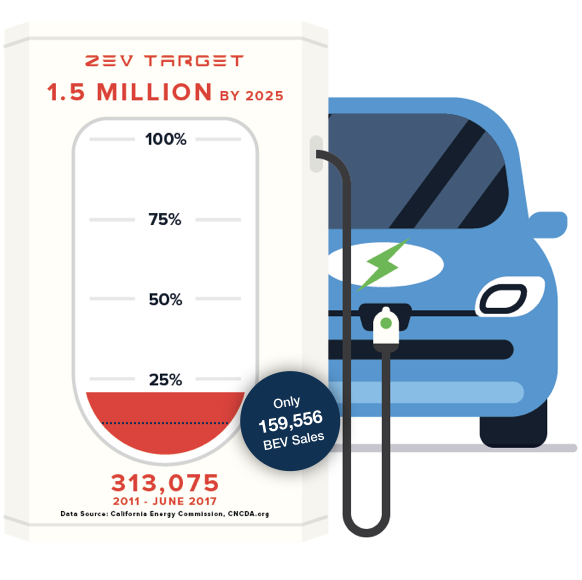The latest second quarter new vehicle sales data from California New Car Dealers Association shows slowing growth in Californians’ purchases of new cars and trucks, although sales remain on track to exceed 2 million once again in 2017. Key findings from the data:
Light Trucks Over Half of New Vehicle Sales
- Total light vehicle sales in 2017:Q2 YTD: 1,026,882. Down 2.0% from 2016 through Q2.
- 2017:Q2 YTD market share, cars: 49.9%. Down from 54.9% in 2016:Q2.
- 2017:Q2 YTD market share, light trucks: 50.1%. Up from 45.1% in 2016:Q2.
- California average price per gallon regular gasoline, 2017:Q2: $3.02. Up from $2.81 in 2016:Q2.

PEV Sales Up in Second Quarter
- 2017:Q2 PEV sales (plug-in hybrids and battery electric vehicles) at 22,427 vehicles, up from 17,941 in 2016:Q2. Total market share for PEVs was 4.3%, up from 3.3% in 2016:Q2 but down from 4.8% in 2017:Q1.
- True EV sales (battery electric vehicles) at 11,828 vehicles, up from 9,967 in 2016:Q2, with market share going from 1.8% in 2016:Q2 to 2.3% in 2017:Q2.
- Hybrid sales (except for plug-in hybrids) at 24,321, up from 22,611 in 2016:Q2. Total market share was 4.7%, up from 4.2% in 2016:Q2.

Cumulative PEV Sales at 20.9% of 2025 Goal-True ZEVs Only 10.6%
As part of the AB 32 climate change program, Executive Order B-16-2012 administratively created a goal of 1.5 million zero-emission vehicles (ZEVs) on California roads by 2025, with a sub-goal that their market share is expanding at that point. The order also established interim mileposts primarily related to infrastructure support for recharging along with more qualitative targets for manufacturing capacity and commercial viability of these vehicles.
Rather than only true ZEVs, implementation of this goal has been interpreted by the agencies as being met by both BEVs that run only on electricity and PHEVs which run on both electricity and motor fuels. Additionally, FCEVs (fuel cell electric vehicles) also would count towards the ZEV total, but to date, just over 300 have been registered in the state.
Using the current agency interpretations of the Executive Order, total PEV sales since 2011 account for 20.9% of the 2025 goal. True ZEV sales (BEVs), however, account for only 10.6%.
Previous Center updates were based on the most current Energy Commission estimates for ZEVs currently registered and actually operating on California’s roads, updated with the CNCDA quarterly sales data. The most recent Energy Commission update, however, has shifted from tracking progress based on registrations to reporting of cumulative ZEV sales based on estimates from an outside organization. The numbers, therefore, overestimate the number of ZEVs actually operating in the state by not taking into account ZEVs that have been moved out of state, traded in, involved in accidents, or otherwise removed from operation on the state’s roads. The tracking graphic below has been revised to conform to the Energy Commission’s current approach.
As an indication of the significance of this change, the previous Energy Commission estimate of registrations showed an 8% drop-off from the then-current cumulative sales number, a factor consistent with fleet-turnover rates for vehicles of this type. Applying this factor to the latest sales total, the actual progress rate consistent with the Executive Order language would be 19.2% rather than the 20.9% shown in the chart below.
Accounting for normal fleet turnover rates and reductions from persons moving out of California, PEV sales even under the revised Energy Commission approach would need to be nearly twice as large in order to meet the 2025 goal. Counting only true ZEVs, sales of BEVs would need to be nearly 4 times as large.

Manufacturing Provisions of the Executive Order Still Not Implemented
Executive Order B-16-2012 also contains a number of provisions calling for actions to expand the ZEV and ZEV component manufacturing base in California:
- [By 2015] The State’s manufacturing sector will be expanding zero-emission vehicle and component manufacturing;
- [By 2020] The private sector’s role in the supply chain for zero-emission vehicle component development and manufacturing State will be expanding.
- [By 2025] The zero-emission vehicle industry will be a strong and sustainable part of California’s economy;
The state’s current energy costs, additional labor law restrictions and litigation risks, and lengthy permitting processes continue to limit the expansion of the ZEV related manufacturers choosing to locate within California. Rather than tackle these well-documented barriers to new manufacturing jobs, the most recent version of the ZEV Action Plan instead calls primarily for data collection and conversations:
Moving forward, state government will play a central role connecting regions to share best practices, gathering economic data to measure ZEV market growth and ensuring our workforce is trained to meet future needs.
Since the last update, the following investments have been announced to locate ZEV-related manufacturing jobs outside of California:
- Following a continuing move of EV manufacturing to China instead of California, Governor Brown sought the help of Chinese manufacturers in meeting the state’s goals during his June trade mission.
- In August, Faraday announced plans to refurbish a former tire plant in Hanford as their first production facility. As indicated in the press reports, Faraday has previously announced plant openings in other locations which were subsequently abandoned, but recently secured $200 million in new financing.
- In August, Ford Motor announced plans to pursue a joint venture with Anhui Zotye Automobile to produce electric vehicles in China.
- In August, GM announced it will begin selling a $5,300 (net of incentives) vehicle produced by its joint venture in China.
- In August, Honda announced the beginning of sales of its Japan-produced Clarity electric vehicle in California and Oregon.
- In August, LG Electronics announced plans for a 250,000 sq ft facility to manufacture electric vehicle components in Michigan.
- In June, Tesla revealed it was in talks to set up a manufacturing facility near Shanghai.

